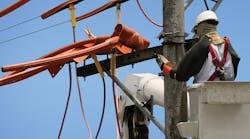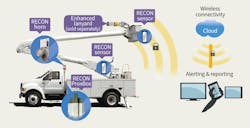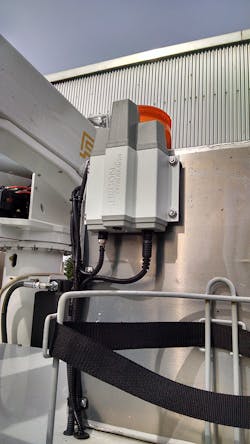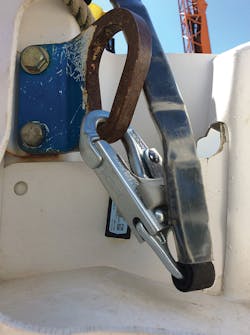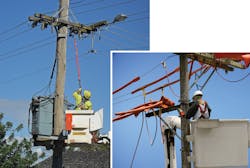When drivers forget to click in their seat belt, a loud, audible warning reminds them to buckle up. But when linemen get in a bucket truck and forget to clip in their lanyards, there is no warning signal. This oversight puts lives at risk. Ejection from a car hitting the back of the truck or a fatal fall from leaning too far to reach an object are real dangers to linemen in bucket trucks. Both of these catastrophic incidents could have been prevented with one simple step: clipping in the lanyard to the bucket.
When Potelco Inc., a Quanta Services company, recognized this problem and potential risk, it came up with a product idea to protect not only its linemen, but also linemen throughout the industry. After creating the initial prototype, Potelco turned to RECON Dynamics to create and refine a product for commercial use. The end result—the Aerial Harness Training System—is built on Internet of Things devices and patented by RECON. The system reminds field personnel to clip their lanyard in, similar to a seatbelt warning.
Developing the Invention
About three years ago, Potelco’s fleet management team submitted an idea for the bucket truck training device to the company’s CEO Innovation Award competition. The fleet team won the award, and Potelco began conducting research and development.
After creating a manual prototype, Potelco brought in Bothell, Washington-based RECON Dynamics to create and commercialize a new product. In turn, the manufacturer infused the product with the latest in wireless sensor technology, bringing a whole host of new options for Potelco to take advantage of. For example, every time the alarm goes off, it can send a notification to the safety team, while the performance data is sent to the company for analysis and follow up.
Since the partnership was formed about three years ago, Potelco and RECON Dynamics have been able to work together to make improvements from real-world feedback. The system has improved to the point that last year, the utility contractor installed it on all 300 of its bucket trucks, and every region has gone live with the system. The company can now pull reports from its phone or computer and inspect performance data for reporting, training and compliance purposes. In turn, the company can better protect its workers, minimize injuries and help to reduce costs.
Striving to Change Behavior
By installing the Aerial Harness Training System in each of its trucks, Potelco aims to modify the behavior of its linemen. While it’s a federal requirement to clip in when raising a bucket up to a certain height, a lineman may forget just one time—and that may be the time they get injured.
Linemen are trained to clip in during their apprenticeship, however they must do it repeatedly to reinforce the behavior and perform it without a second thought. Creating this automatic behavior becomes especially important when linemen switch from one truck to another piece of equipment. If they are not accustomed to the vehicle, they may forget to clip in, putting themselves at risk. Just as a seatbelt is only effective if it is actually used, the same applies to a fall protection device.
Similar to other utilities and utility contractors, Potelco’s training program covers the requirements of clipping in a lanyard when using a bucket truck. By equipping its bucket trucks with the Aerial Harness Training System, Potelco is implementing an added layer of protection to create safe work behaviors.
During the training program, the safety team trains linemen on the rules of fall protection and educates them about the dangers of not being clipped in. RECON’s system has become an extension of the utility contractor’s program, and it elevates Potelco to the next level by helping with accountability and consistency. With the Aerial Harness Training System in place, it adds an additional layer of safety to help Potelco meet its goal of “Zero Incidents Everyday.”
Analyzing Data
The Aerial Harness Training System sends notifications from each individual truck to Potelco so the utility contractor can review the performance of its workers. The company is still early in the process of using the data, but in the future, hopes to analyze it to better protect its workers. For example, if workers are struggling to create the behavior of clipping in, their manager can have a conversation with them about how to increase their usage of the safety equipment, therefore creating safe work behaviors.
Through data analysis, a manager can also uncover a roadblock and work with the employee to either change the behavior or obtain a different fall arrest device. For example, one employee was struggling to clip in his lanyard, setting off the alarm. Upon further investigation, it was discovered that the attachment point for the harness was too tight, and it was challenging to clip it in properly. By making a modification to the truck, Potelco made it easier for the person to clip in.
Installing the System
The RECON system is built on wireless technology, is simple to install and is designed to work with a wide variety of bucket truck and lanyard configurations. The system consists of a RECON communications unit, an audible alarm, and RECON sensors. A sensor and indicator chip detect the boom being raised out of the cradle. At the same time, a sensor is also placed at each of the tie-off points on the bucket.
As for system size, the proximity chips only measure about an inch wide and half an inch thick. They’re designed to be positioned at attachment points of the lanyard and truck. These sensors work on any bucket truck, regardless of the configuration of the attachment point. Also, the other significant part of the system—the horn—is a small, 6 in. x 5 in. box mounted on the truck.
The fall protection harness is attached to the lanyard between the operator’s shoulder blades with proximity indicator chips installed near or on the lanyard clip to complete the system. The operator is safe, and no alarm sounds when the RECON sensor in the bucket detects that the lanyard proximity chips are near it—indicating the operator has clipped in.
At Potelco, the linemen are trained to clip in immediately when they get into the bucket. The RECON system sounds the audible alarm if the bucket arm is raised out of the cradle without detecting an operator clipping in. When the audible alarm sounds, the alarm is similar to a loud car alarm, and it goes off for about 10 seconds. The volume and duration of the alarm can be remotely adjusted to the company’s preference.
So far, the linemen think the product is an interesting invention. Feedback from the field is that they would rather hear the alarm for a few seconds, then forget to clip-in and be at risk of falling out of the bucket.
Making Modifications
Potelco’s field workforce has used full body harnesses and lanyard attachments for years, but the materials have changed over time. Today, the utility contractor must be compliant with the requirements for flame-retardant properties. With that in mind, Potelco, RECON Dynamics, and Buckingham Manufacturing worked together to create an OEM lanyard that meets the latest requirements. Buckingham sewed the proximity chips into the fabric of the lanyard and eliminated a step in the install process.
In the past, chips needed to be glued on to the lanyard, but occasionally fell off, which caused some problems. An advantage of the Potelco/RECON partnership is the ability to recognize in-field problems like these and work to solve them as quickly as possible.
The product has been operational for over two years and commercially available for more than a year. The system is in service with several large utility contractors in the United States, in addition to others like electric utilities. In 2019, RECON anticipates having the system installed on more than 2000 trucks.
Bryan Sabari ([email protected]) is the vice president of safety, training and compliance for Potelco.
For more information:
Buckingham Manufacturing | www.buckinghammfg.com
Potelco | www.potelco.net
RECON Dynamics | www.buckettrucksafety.com
